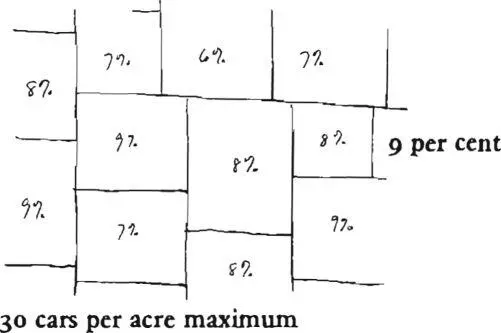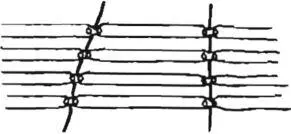Christopher alexander - A pattern language
Здесь есть возможность читать онлайн «Christopher alexander - A pattern language» весь текст электронной книги совершенно бесплатно (целиком полную версию без сокращений). В некоторых случаях можно слушать аудио, скачать через торрент в формате fb2 и присутствует краткое содержание. Жанр: Прочая научная литература, на английском языке. Описание произведения, (предисловие) а так же отзывы посетителей доступны на портале библиотеки ЛибКат.
- Название:A pattern language
- Автор:
- Жанр:
- Год:неизвестен
- ISBN:нет данных
- Рейтинг книги:3 / 5. Голосов: 1
-
Избранное:Добавить в избранное
- Отзывы:
-
Ваша оценка:
- 60
- 1
- 2
- 3
- 4
- 5
A pattern language: краткое содержание, описание и аннотация
Предлагаем к чтению аннотацию, описание, краткое содержание или предисловие (зависит от того, что написал сам автор книги «A pattern language»). Если вы не нашли необходимую информацию о книге — напишите в комментариях, мы постараемся отыскать её.
A pattern language — читать онлайн бесплатно полную книгу (весь текст) целиком
Ниже представлен текст книги, разбитый по страницам. Система сохранения места последней прочитанной страницы, позволяет с удобством читать онлайн бесплатно книгу «A pattern language», без необходимости каждый раз заново искать на чём Вы остановились. Поставьте закладку, и сможете в любой момент перейти на страницу, на которой закончили чтение.
Интервал:
Закладка:
Cars per Per cent on Per cent in two Per cent in three acre surface story garages story garages
What about underground parking? May we consider it as an exception to this rule? Only if it does not violate or restrict the use of the land above. If, for example, a parking garage is under a piece of land which was previously used as open space, with great trees growing on it, then the garage will almost certainly change the nature of the space above, because it will no longer be possible to grow large trees there. Such a parking garage is a violation of the land. Similarly, if the structural grid of the garage— 60 foot bays—constrains the structural grid of the building above, so that this building is not free to express its needs, this is a violation too. Underground parking may be allowed only in those rare cases where it does not constrain the land above at all: under a major road, perhaps, or under a tennis court.
We see then, that the 9 per cent rule has colossal implications.
Since underground parking will only rarely satisfy the conditions we have stated, the pattern really says that almost no part of the urban area may have more than 30 parking spaces per acre. This will create large changes in the central business district. Consider a part of a typical downtown area. There may be several hundred commuters per acre working there; and, under today’s conditions, many of them park their cars in garages. But if it is true that there cannot be more than 30 parking spaces per acre, then either the work will be forced to decentralize, or the workers will have to rely on public transportation. It seems, in short, that this simple pattern, based on the social psychology of the environment, leads us to the same far reaching social conclusions as the patterns web
OF PUBLIC TRANSPORTATION (l6) and SCATTERED WORK (9).
Therefore:
Do not allow more than 9 per cent of the land in any given area to be used for parking. In order to prevent the “bunching” of parking in huge neglected areas, it is necessary for a town or a community to subdivide its land into “parking zones” no larger than 10 acres each and to apply the same rule in each zone.
| parking zones |
|---|
 |
*
Two later patterns say that parking must take one of two forms: tiny, surface parking lots, or shielded parking structures—
1 24
SHIELDED PARKING (97), SMALL PARKING LOTS (1O3). If yOU accept these patterns the 9 per cent rule will put an effective upper limit of 30 parking spaces per acre, on every part of the environment. Present-day on-street parking, with driveways, which provides spaces for about 35 cars per acre on the ground is ruled out. And those present-day high density business developments which depend on the car are also ruled out. . . .
A PATTERN LANGUAGE
We have spent years trying to formulate this language, in the hope that when a person uses it, he will be so impressed by its power, and so joyful in its use, that he will understand again, what it means to have a living language of this kind. If we only succeed in that, it is possible that each person may once again embark on the construction and development of his own language— perhaps taking the language printed in this book, as a point of departure.
And yet, we do believe, of course, that this language which is printed here is something more than a manual, or a teacher, or a version of a possible pattern language. Many of the patterns here are archetypal—so deep, so deeply rooted in the nature of things, that it seems likely that they will be a part of human nature, and human action, as much in five hundred years, as they are today. We doubt very much whether anyone could construct a valid pattern language, in his own mind, which did not include the pattern arcades (119)for example, or the pattern alcoves (179).
In this sense, we have also tried to penetrate, as deep as we are able, into the nature of things in the environment: and hope that a great part of this language, which we print here, will be a core of any sensible human pattern language, which any person constructs for himself, in his own mind. In this sense, at least a part of the language we have presented here, is the archetypal core of all possible pattern languages, which can make people feel alive and human.
| 23 PARALLEL ROADS |
|---|
 |
I 26
. . . in earlier patterns, we have proposed that cities should be subdivided into local transport areas, whose roads allow cars to move in and out from the ring roads, but strongly discourage internal movement across the area—local transport areas (ii), ring roads (17)—and that these transport areas themselves be further subdivided into communities and neighborhoods, with the provision that all major roads are in the boundaries between communities and neighborhoods—subculture boundary (13), neighborhood boundary (15). Now, what should the arrangement of these roads be like, to help the flow required by local transport areas (i i), and to maintain the boundaries?
The net-like pattern of streets is obsolete. Congestion is choking cities. Cars can average 60 miles per hour on freeways, but trips across town have an average speed of only 10 to 15 miles per hour.
Certainly, in many cases, we want to get rid of cars, not help them to go faster. This is fully discussed in local transport areas (ii). But away from the areas where children play and people walk or use their bikes, there still need to be certain streets which carry cars. The question is: How can these streets be designed to carry the cars faster and without congestion?
It turns out that the loss of speed on present city streets is caused mainly by crossing movements: left-hand turns across traffic and four-way intersections. (G. F. Newell, “The Effect of Left Turns on the Capacity of Traffic Intersection,” Quarterly of Applied Mathematics , XVII, April 1959, pp. 67—76.)
To speed up traffic it is therefore necessary to create a network of major roads in which there are no four-way intersections, and no left-hand turns across traffic. This can easily be done if the major roads are alternating, one-way parallel roads, a few hundred feet apart, with smaller local roads opening off them, and the only connections between the parallel roads given by larger freeways crossing them at two- or three-mile intervals.
1 27
 |
| Parallel roads . |
This pattern has been discussed at considerable length in three papers (“The Pattern of Streets,” C. Alexander, AIF Journal , September 1966; Criticisms by D. Carson and P. Roosen-Runge, and Alexander’s reply, in A IP Journal , September 1967.) We refer the reader to these original papers for the full derivation of all the geometric details. Our present statement is a radically condensed version. Here we concentrate mainly on one puzzling question—that of detours—because this is for many people the most surprising aspect of the full analysis.
The pattern of parallel roads—since it contains no major cross streets—creates many detours not present in today’s net-like pattern. At first sight it seems likely that these detours will be impossibly large. However, in the papers mentioned above it is shown in detail that they are in fact perfectly reasonable. We summarize the argument below.
Читать дальшеИнтервал:
Закладка:
Похожие книги на «A pattern language»
Представляем Вашему вниманию похожие книги на «A pattern language» списком для выбора. Мы отобрали схожую по названию и смыслу литературу в надежде предоставить читателям больше вариантов отыскать новые, интересные, ещё непрочитанные произведения.
Обсуждение, отзывы о книге «A pattern language» и просто собственные мнения читателей. Оставьте ваши комментарии, напишите, что Вы думаете о произведении, его смысле или главных героях. Укажите что конкретно понравилось, а что нет, и почему Вы так считаете.












